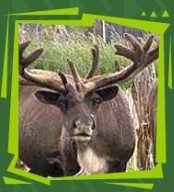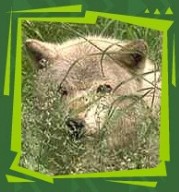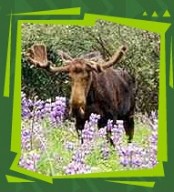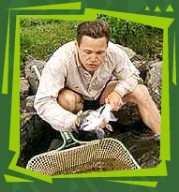Hey Zoogers, I started off my Alaskan adventure by flying an airplane to get a closer look
at those shy and reclusive birds, puffins. I had to leave my plane to climb up high enough
to observe the puffin rookery.

The tuffed puffin resembles a cross between a parrot and a penguin. These unique birds'
wings are designed for diving and swimming. Puffins plunge down into the water at top
speeds, utilizing their wings to move deeper down to catch their prey. Tuffed puffins
can hold up to 30 fish in their bills!
Puffins are wonderful creatures indeed; however, the creature we're looking for is the
brown bear. I went back to my sea plane to call my friend Clint on the radio. He was just
about to give me the exact location where he had spotted some brown bears a few hours
before, but our communication got cut off.
Flying is a great way to get around Alaska, but I decided to hike inland for a while,
searching for the brown bear.
Along the way I came across some Dall sheep, which wasn't too hard -- there are actually
more of these animals than humans in Alaska. The male and female of these animals can be
told apart on sight. The rams have huge, while the females have smaller ones.

Dall sheep have adapted to live life on angular terrain. They have cloven hooves that dig
into the substrate, which makes it possible for them to run over rocks.
As I hiked on, the ground was covered with hoof imprints. After I followed the tracks, a
clicking sound confirmed that the tracks belonged to some caribou, a type of deer. Caribou
have tendons in their feet that snap across a bone to make the clicking noise I heard.

Basically, the caribou spend their time searching the tundra for grass so they can eat, eat,
eat. These amazing animals are perfectly designed for the tundra. Their fur keeps them
warm and their antlers allow them to push off predators. Since the digits on their feet are
widespread, caribou have built-in "snowshoes." Caribou are designed to reach speeds of up to
50 miles an hour, so you never want to get in their paths.
Woah, with all those amazing animals, I forgot I was looking for the brown bear. As I was
looking around for a place to make camp, I stumbled upon an alpine wolf. These animals have
the largest natural range of any living terrestrial mammal other than humans!

Alpine wolves are extremely social. They travel in a tight, extended unit. There is a solid
system of hierarchy. The alpha pair runs their society, which can extend over 400 miles
of territory. Alpine wolves need lots of space, so it was time to give this wolf his.
The next morning it was time to jump in my plane again. From the air, I was able to spot
a brown bear on the beach, combing for Pacific razor clams, but there was nowhere to land,
so I I had to continue on and walk back.

There was a large brown creature ahead of me in a clearing, but it turned out to be a
moose, not the brown bear. Moose can weigh more than 1,600 pounds! The males have horns
and the females do not. The male moose's antlers can grow to about two meters across.
The hard antlers are usually covered with a velvet-like fur, but I don't advise trying to
get close enough to touch them. Those antlers can do a lot of damage to humans!

I moved towards the river, where salmon spawning was in full swing. Every year, salmon
return to the same river they were born in to breed. The female uses her tail to make a
hole in the river floor. She lays eggs, which the male comes along and fertilizes. The
females die a few weeks after laying their eggs.
Bald eagles and brown bears love to feed on salmon, so I knew we weren't far from finding
a brown bear. Not much farther inland, I came across a clearing with a most unusual site --
a mother brown bear and her two cubs, as well a single male brown bear.
It is unusual to see the mother and cubs so close to the male, because brown bears are
solitary by nature, Brown bears will prey on other bears by killing off their cubs, then
mating with the females.
The females spend all of their energy to protect their cubs. Brown bear mothers are quality
moms. They spend anywhere from two to five years raising their cubs.
Well, after seeing such tremendous animals, our quest in Alaska has come to a close.
Stay Wild,
Jeff
Back to Jeff's Journals